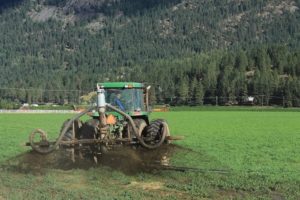Nitrate Contamination in Hullcar Aquifer, North Okanagan Region
In January of this year, the BCGWA was approached by the Save the Hullcar Aquifer Team (SHAT) with a request for support in that organization’s struggle to address nitrate contamination in Provincially-mapped Aquifer 103. Aquifer 103 is a shallow, unconfined aquifer system located in the Deep Creek valley west of Armstrong, B.C. The aquifer is used by numerous residential and agricultural groundwater users, and in addition, discharges to Steele Springs, which is the water source for the Steele Springs Waterworks District. The Steele Springs Waterworks District is a public water supplier that provides water to 250 residents in their service area.
Since 2005, nitrate concentrations in Steele Springs have increased from approximately 1.6 mg/L to over 12 mg/L. The health-based Maximum Acceptable Concentration for Nitrate in the Canadian Drinking Water Quality Guidelines is 10 mg/L, and this guideline has been consistently exceeded since March 2014. In keeping with our mandate to be advocates for the protection of groundwater resources, the BCGWA prepared a letter in January in response to SHAT’s request.
In March, an Inter-Ministry Hullcar Aquifer Working Group was formed and on May 12, the Ministry of Environment issued Pollution Abatement Orders to several agricultural operations above the aquifer who are practicing land application of solid manure and/or manure laden effluent. If you are interested in finding out more information on groundwater contamination issues in the area, a quick Google search for “Hullcar Aquifer” will lead you to numerous articles, the SHAT Facebook page, as well as a link maintained by the Ministry of Environment related to the issue.
